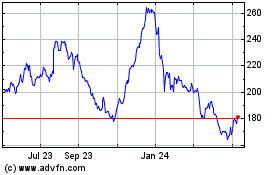NASA's Latest Capsules Expected to Pose Greater Risks Transporting Astronauts Than Originally Projected--Update
May 26 2017 - 4:05PM
Dow Jones News
By Andy Pasztor
NASA's next-generation manned spacecraft, initially envisioned
to be roughly 10 times safer than the retired space shuttle fleet,
will fall significantly short of that goal, according to industry
and former agency officials.
Two fleets of commercially developed crew taxis separately being
built by Boeing Co. and Elon Musk's SpaceX, as well as the Orion
deep-space capsule under development by a Lockheed Martin Corp.-led
team, still are expected to meet minimum government risk standards,
according to a National Aeronautics and Space Administration
spokeswoman. But questions about relative safety, costs and
engineering trade-offs -- which have roiled the space community for
more than a decade -- are coming to the fore as the agency moves
toward certifying the new vehicles and locking in launch
schedules.
After the space shuttle Columbia exploded during re-entry in
2003, killing all seven crew members, the head of NASA's astronaut
office urged management to adopt a safety standard for future human
spacecraft of no more than one projected fatal accident per 1,000
flights. But that quickly proved technically unachievable. So when
the space shuttles were retired in 2011 after a total of 135
flights, including two catastrophes, the hope was that future
spacecraft would meet a standard of one fatal accident per roughly
700 flights -- roughly 10 times safer than the shuttles.
Yet that benchmark also was adjusted downward over the years, as
detailed rocket and capsule designs were altered and entire
programs were scrapped or overhauled. "There is no way they can
achieve those numbers in the real world," according to Don Nelson,
a retired NASA engineer who raised safety concerns before the
Columbia tragedy.
Now, NASA says Boeing and Mr. Musk's Space Exploration
Technologies Corp. will be mandated to meet a standard of no more
than one potential catastrophic event in 270 flights, more than
twice as risky as the proposed post-shuttle benchmark. NASA said it
hasn't yet calculated even general safety standard covering the
entire first Orion flight intended to carry astronauts to the
vicinity of the moon, anticipated to last about three weeks.
Industry officials, however, said NASA has issued "design guidance"
covering capsule safety on that mission, for which a trajectory
already has been decided. The number is no more than one fatal
accident in 240 flights.
The commercial capsules are expected to conduct routine flights
by mid-2019, which means they probably have to be well on the way
to being certified before the end of next year.
An agency spokeswoman said "our safety requirements remain
consistent" across commercial and traditional acquisition programs
intended to transport astronauts, adding that specific calculations
are based on factors ranging from duration of the flight to
proximity to tiny meteorites to likely radiation exposure. NASA
said the guidance number for Orion doesn't reflect launch hazards
and certain other risks associated with the projected overall
mission.
Underlying the numbers, NASA is struggling with a host of
technical issues amid wide-ranging industry discussions over the
variability of agency safety assessments. Experts inside and
outside the government describe existing risk calculations as often
imprecise. Such statistical measures, officially called "loss of
crew" numbers, are based on various engineering assumptions and can
shift markedly depending on design changes and revised mission
profiles. They also can be wildly optimistic. Just before the space
shuttles stopped flying, NASA determined that based on their actual
flight history and documented safety incidents, the statistical
chance of having a catastrophic failure fatal to the crew was
roughly one in nine.
Against this confusing backdrop, William Gerstenmaier, a career
NASA official with three decades of high-level experience who is in
charge of human exploration, told an industry-government conference
earlier this year in Washington that lawmakers, agency officials
and the public have failed to explicitly acknowledge the full
extent of the risks.
Based on physics and the nature of space flight, he said, in the
end "we're going to be flying with some risk, no matter how hard we
try to remove that risk."
NASA and its supporters "should figure out a better way to talk
about these risks," Mr. Gerstenmaier told the conference, "not to
scare people" but "just to recognize what they are."
Write to Andy Pasztor at andy.pasztor@wsj.com
(END) Dow Jones Newswires
May 26, 2017 16:50 ET (20:50 GMT)
Copyright (c) 2017 Dow Jones & Company, Inc.
Boeing (NYSE:BA)
Historical Stock Chart
From Mar 2024 to Apr 2024

Boeing (NYSE:BA)
Historical Stock Chart
From Apr 2023 to Apr 2024
